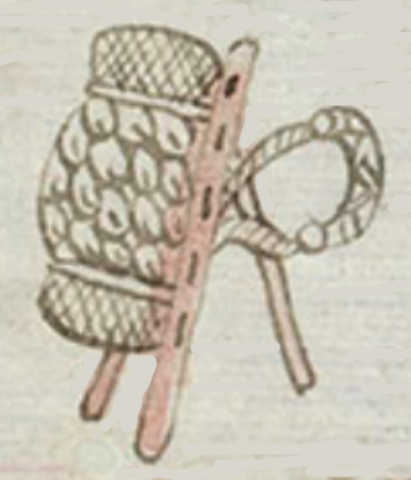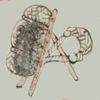tlamamalli (CST35)
This painting of the simplex glyph for the term tlamamalli (a load borne by a human carrier) shows the load tied to a carrying frame that is standing on its own, with an extra leg pulled out to the right to help hold it up. The frame is pinkish and made of two vertical, parallel pieces of wood that have slats connecting them horizontally. There are five slats on this one, made visible only at the ends where they penetrate the vertical boards. The bundle on the frame is probably wrapped with a woven mat. A tumpline with a brace for the forehead is tied to the frame, too. The companion text says that this is a load of cacao beans (“cacavatl,” i.e., cacahuatl), which are visible inside the bundle. This cacao would be made into a hot chocolate drink to be consumed by the “lords of the palace,” in Kevin Terraciano’s translation (Codex Sierra, 2021, 156).
Stephanie Wood
For more on the Codex Sierra, see Kevin Terraciano’s study (2021).
Stephanie Wood
1550–1564
Jeff Haskett-Wood
madera, tecnología, petates, cargas, cacao, cocoa, bebidas, manojo, bulto, cargas, cargar, mecapalli, mecapal, mecapales, ixcuamama, tlamama, petlatl, soga, mecate, mecates, cuerda, cuerdas, sogas, cordones, cordel, cordeles

tlamamal(li), a load typically borne by human carriers, https://nahuatl.wired-humanities.org/content/tlamamalli
la carga, o el bulto
Stephanie Wood
Códice Sierra-Texupan, plate 35, page dated 1561. Origin: Santa Catalina Texupan, Mixteca Alta, State of Oaxaca. Kevin Terraciano has published an outstanding study of this manuscript (Codex Sierra, 2021), and in his book he refers to alphabetic and “pictorial” writing, not hieroglyphic writing. We are still counting some of the imagery from this source as hieroglyphic writing, but we are also including examples of “iconography” where the images verge on European style illustrations or scenes showing activities. We have this iconography category so that such images can be fruitfully compared with hieroglyphs. Hieroglyphic writing was evolving as a result of the influence of European illustrations, and even alphabetic writing impacted it.
https://bidilaf.buap.mx/objeto.xql?id=48281&busqueda=Texupan&action=search
The Biblioteca Digital Lafragua of the Biblioteca Histórica José María Lafragua in Puebla, Mexico, publishes this Códice Sierra-Texupan, 1550–1564 (62pp., 30.7 x 21.8 cm.), referring to it as being in the “Public Domain.” This image is published here under a Creative Commons license, asking that you cite the Biblioteca Digital Lafragua and this Visual Lexicon of Aztec Hieroglyphs.




